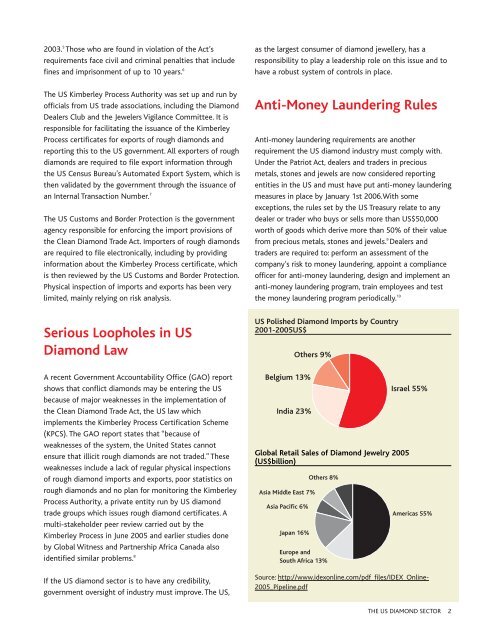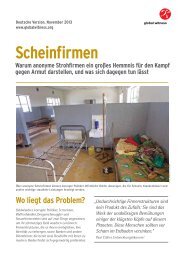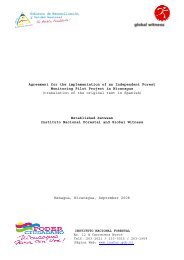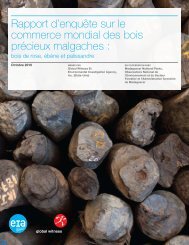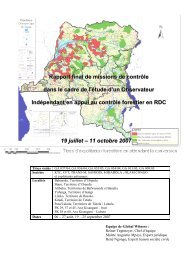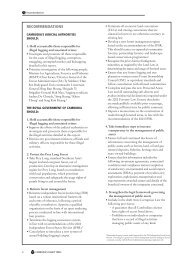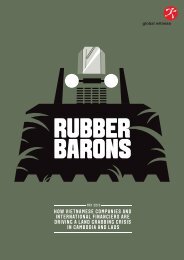The US Diamond Sector - Global Witness
The US Diamond Sector - Global Witness
The US Diamond Sector - Global Witness
Create successful ePaper yourself
Turn your PDF publications into a flip-book with our unique Google optimized e-Paper software.
2003. 5 Those who are found in violation of the Act’s<br />
requirements face civil and criminal penalties that include<br />
fines and imprisonment of up to 10 years. 6<br />
<strong>The</strong> <strong>US</strong> Kimberley Process Authority was set up and run by<br />
officials from <strong>US</strong> trade associations, including the <strong>Diamond</strong><br />
Dealers Club and the Jewelers Vigilance Committee. It is<br />
responsible for facilitating the issuance of the Kimberley<br />
Process certificates for exports of rough diamonds and<br />
reporting this to the <strong>US</strong> government. All exporters of rough<br />
diamonds are required to file export information through<br />
the <strong>US</strong> Census Bureau’s Automated Export System, which is<br />
then validated by the government through the issuance of<br />
an Internal Transaction Number. 7<br />
<strong>The</strong> <strong>US</strong> Customs and Border Protection is the government<br />
agency responsible for enforcing the import provisions of<br />
the Clean <strong>Diamond</strong> Trade Act. Importers of rough diamonds<br />
are required to file electronically, including by providing<br />
information about the Kimberley Process certificate, which<br />
is then reviewed by the <strong>US</strong> Customs and Border Protection.<br />
Physical inspection of imports and exports has been very<br />
limited, mainly relying on risk analysis.<br />
Serious Loopholes in <strong>US</strong><br />
<strong>Diamond</strong> Law<br />
A recent Government Accountability Office (GAO) report<br />
shows that conflict diamonds may be entering the <strong>US</strong><br />
because of major weaknesses in the implementation of<br />
the Clean <strong>Diamond</strong> Trade Act, the <strong>US</strong> law which<br />
implements the Kimberley Process Certification Scheme<br />
(KPCS). <strong>The</strong> GAO report states that “because of<br />
weaknesses of the system, the United States cannot<br />
ensure that illicit rough diamonds are not traded.” <strong>The</strong>se<br />
weaknesses include a lack of regular physical inspections<br />
of rough diamond imports and exports, poor statistics on<br />
rough diamonds and no plan for monitoring the Kimberley<br />
Process Authority, a private entity run by <strong>US</strong> diamond<br />
trade groups which issues rough diamond certificates. A<br />
multi-stakeholder peer review carried out by the<br />
Kimberley Process in June 2005 and earlier studies done<br />
by <strong>Global</strong> <strong>Witness</strong> and Partnership Africa Canada also<br />
identified similar problems. 8<br />
If the <strong>US</strong> diamond sector is to have any credibility,<br />
government oversight of industry must improve. <strong>The</strong> <strong>US</strong>,<br />
as the largest consumer of diamond jewellery, has a<br />
responsibility to play a leadership role on this issue and to<br />
have a robust system of controls in place.<br />
Anti-Money Laundering Rules<br />
Anti-money laundering requirements are another<br />
requirement the <strong>US</strong> diamond industry must comply with.<br />
Under the Patriot Act, dealers and traders in precious<br />
metals, stones and jewels are now considered reporting<br />
entities in the <strong>US</strong> and must have put anti-money laundering<br />
measures in place by January 1st 2006.With some<br />
exceptions, the rules set by the <strong>US</strong> Treasury relate to any<br />
dealer or trader who buys or sells more than <strong>US</strong>$50,000<br />
worth of goods which derive more than 50% of their value<br />
from precious metals, stones and jewels. 9 Dealers and<br />
traders are required to: perform an assessment of the<br />
company’s risk to money laundering, appoint a compliance<br />
officer for anti-money laundering, design and implement an<br />
anti-money laundering program, train employees and test<br />
the money laundering program periodically. 10<br />
<strong>US</strong> Polished <strong>Diamond</strong> Imports by Country<br />
2001-2005<strong>US</strong>$<br />
Belgium 13%<br />
India 23%<br />
Others 9%<br />
<strong>Global</strong> Retail Sales of <strong>Diamond</strong> Jewelry 2005<br />
(<strong>US</strong>$billion)<br />
Asia Middle East 7%<br />
Asia Pacific 6%<br />
Japan 16%<br />
Others 8%<br />
Europe and<br />
South Africa 13%<br />
Israel 55%<br />
Americas 55%<br />
Source: http://www.idexonline.com/pdf_files/IDEX_Online-<br />
2005_Pipeline.pdf<br />
THE <strong>US</strong> DIAMOND SECTOR 2


